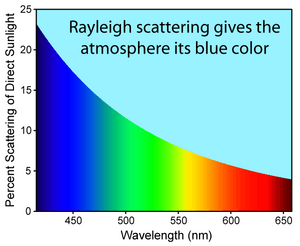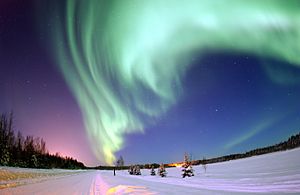Sky facts for kids
The sky is the big, open space we see above us when we look up. On a clear day, it looks blue. The blue color gets deeper the higher we look, right up to the point directly above our heads.
The sky looks blue because of tiny gas molecules in the air. These molecules scatter sunlight. This scattering is called Rayleigh scattering. Sunlight is actually made up of all the colors of the rainbow, which together look white. But blue light scatters much more than red light. That's why the sky appears blue on a clear, cloudless day.
Contents
What Makes the Sky Blue?
Most of the light we see in the daytime sky comes from sunlight being scattered by the air. This scattering is strongest for blue light. So, the scattered light we see is bluer than the actual sun. The sunlight that reaches us directly, after losing some of its blue parts, looks a little less blue.
Clouds also scatter light, but in a different way. Individual water droplets in a cloud can create colored rings. But if a cloud is very thick, the light scatters many times, mixing all the colors together. This makes thick clouds look white or gray.
Why the Sky Changes Colors


The sky can change to many colors like red, orange, purple, and yellow. This often happens near sunset or sunrise. At these times, sunlight has to travel through much more of the Earth's atmosphere to reach our eyes. When light travels through more air, even more blue light gets scattered away. This leaves more red, orange, and yellow light to reach us, making the sky look colorful.
If you are at a higher place, like on a tall mountain, the sky looks darker. This is because there is less air above you to scatter light. On the Moon, there is no atmosphere at all. So, the sky on the Moon is always black, even when the sun is shining!
What Happens at Dawn and Dusk?
The brightness of the sky changes a lot throughout the day. When the sun is high, direct scattering of sunlight makes the sky bright. But during twilight, which is the time between sunset and night, or between night and sunrise, things get more interesting.
Sometimes, you might see a "Green flash" right after sunset or before sunrise. This is a quick green spot above the sun that lasts only a second or two. It happens because of how light bends and scatters in the atmosphere, especially when the air temperature changes with height in a special way. You can see green flashes from anywhere, even from an airplane, as long as you have a clear view of the horizon. They can also happen with the Moon or bright planets like Venus and Jupiter.
The Earth's shadow is the shadow our planet casts on its own atmosphere. You can sometimes see this shadow twice a day, around sunset and sunrise. It looks like a dark blue or grayish-blue band right above the horizon, in the part of the sky opposite to the sun. Above this dark band, you might see a pink band called the "Belt of Venus". These two bands blend into each other.
Twilight is divided into three parts based on how far the sun is below the horizon:
- Civil twilight starts after sunset and ends when the sun is 6 degrees below the horizon.
- Nautical twilight is when the sun is between 6 and 12 degrees below the horizon.
- Astronomical twilight is when the sun is between 12 and 18 degrees below the horizon.
After the sun drops more than 18 degrees below the horizon, the sky becomes as dark as it will get.
What the Night Sky Shows Us

The night sky is what we see above us after the sun has set. On a clear night, we can see celestial bodies like stars, the Moon, and planets. Even without the moon or city lights, the sky is not completely dark at night. This is because of natural light sources like moonlight, starlight, and a faint glow from the atmosphere called airglow. If the sky were totally dark, you wouldn't be able to see the outline of objects against it.
People have studied the night sky for thousands of years. In the past, farmers used the stars as a calendar to know when to plant crops. The ancient belief in astrology was based on the idea that the positions of heavenly bodies could affect events on Earth. Today, the scientific study of the night sky and everything in it is called astronomy.
However, seeing the night sky clearly is becoming harder because of light pollution. This is extra light from cities and towns that makes the sky brighter. The Moon also makes the sky brighter, which can make it harder to see faint stars. To get the best views of the night sky, astronomers often go far away from big cities.
Images for kids
-
The sky above the clouds
See also
 In Spanish: Cielo para niños
In Spanish: Cielo para niños









